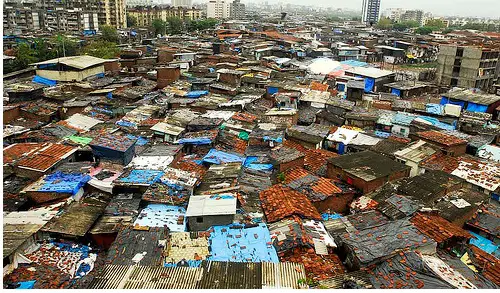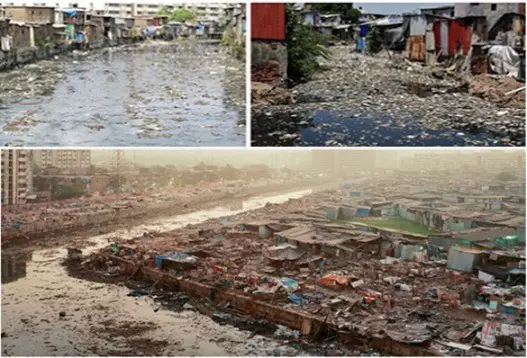Dharavi slum, one of the largest in the world, also attracts Tourists & Filmmakers.

About Dharavi
Dharavi is one of the largest slums in the world, located in the heart of the Mumbai city. Once a fishing village, its original residents were fishermen (called ‘Kolis’ in Mumbai) who used to practise freshwater fishing in the Mithi river.
However, over the last 30 years they have moved to other profitable professions, and the place itself has turned into a huge cluster of slums. Today, its almost like a small city within a huge city, where you see unending stretch of narrow dirty lanes, open sewers and cramped huts.
To most people in India (especially Mumbai), the Dharavi slum may be an embarrassment, but to almost a million people, it’s home.
Although almost half of the city’s population lives in slums (“informal” housing), and their are other slum pockets in Mumbai that almost rival Dharavi in size and squalor, yet its Dharavi that remains unique among slums — something that tourists want to explore and filmmakers want to capture on screen.
It Attracts People from India
To all those who come to Mumbai from remote places in India, this place provides an affordable option to live and figure out how to go about achieving their dreams.
In a city where house rents are on par with cities in developed countries, this place not just provides affordable housing, its location (heart of the city and well connected by train & bus network) makes it convenient to go to work. Most rooms nowadays have electricity, cooking gas stove, and there’s access to water as well (although not 24 hours).
Life is tough though, as you have to pay the local “goons” to get access to basic necessities (water, electricity). But the fact is that by hook or crook, nearly every household has access to water & electricity nowadays.
Most houses do not have attached toilets and the public ones are very poorly (most do not have water facilities). Besides, public toilets are not safe for women to visit at night. The paid public toilets are comparatively better. Some housing colonies build a common toilet (with water facilities) for which residents usually pay about 30-40 rupees a month. Those who live in such colonies obviously take pride in having access to good bathroom/toilet facilities in their locality.

Mumbai may be home to some of the richest in the world, but there are also pockets where you get to see this.
Thriving Business
Because of its scale, Dharavi is also a thriving business centre with several small-scale industries that produce embroidered garments, export quality leather goods, pottery and plastic – these are sold in domestic as well as International markets.
Famous for Leather Goods…
Dharavi is very popular for leather goods, and several lower middle-class Mumbaikars visit the place to get good deals on leather products. During the tech boom (late 1990s and early 2000s), when young Indian IT workers were in demand overseas, you could see several of them here (especially during the months from Oct to Feb) to get quality leather jackets, belts & accessories.
Although the state government has plans to redevelop Dharavi and develop it into a township with proper housing, shopping complexes, hospitals and schools, the progress on that front is quite slow.
Dharavi & Bollywood
Several movies have been filmed in Dharavi. Some of them include Deewar, Salaam Bombay!, Dharavi, Sarkar, Traffic Signal, Footpath.
Parts of the Oscar-award winning film Slumdog Millionaire was also filmed in the Dharavi slum.
In recent times, Amitabh Bachchan and Boman Irani shot a few scenes at Dharavi for their film ‘Bhootnath Returns’. And now it seems, even Farah Khan will shoot some key action scenes in Dharavi for her film ‘Happy New Year’.
And guess who’s the star? Shah Rukh Khan!
Usually one sees SRK at lavish sets and exotic foreign locations, but this time you’ll see the superstar in a different film setting. The filmmakers are in the process of getting special permission to shoot this portion of the film. And because it will be shot in the slums, and considering his popularity among the masses, the film set up will definitely require loads of security arrangement.
I’m sure SRK’s fans will love seeing him in action at these rough and tough real life locations.
Dharavi Rap song in Bhoothnath Returns, Amitabh Bachchan shoots in Dharavi Slum
Acting Classes in Dharavi
I did mention that thousands of people who come to Mumbai, live in Dharavi, because of its affordability and good connectivity to various parts of Mumbai. Tamatar Mandir (Mandir in Hindi means Temple), a Digene-pink shrine in Dharavi’s Shastri Nagar, sees several devotees, who are in Mumbai seeking a break in Bollywood.
Tamatar Mandir is placed alongside Dharavi’s one and only, Baburao Ladsaheb’s Five Star Acting Classes (studio), which operates from a two-room house. You’ll see aspirants queue up here (especially on weekends) to claim a ticket to Bollywood or even television.
Baburao Ladsaheb, the owner, has done several Marathi plays, Bhojpuri films, a music video, small roles in Hindi films and also produced & directed a Marathi film. He’s a popular name among filmmakers and is the man to go to, in order to cast beggars, drunkards and slumdwellers.
“I supplied the beggars in Slumdog Millionaire , the jhopadpatti residents in Paa and an extra in Kaminey. Observe their facial expressions and body language , they were handpicked from hundreds,” says Baburao. To newcomers, Ladsaheb’s mantra to succeed is to get good at ‘acting , dancing, fighting and modelling’.
Now that the film fraternity knows him, does he get embarrassed by the fact that he operates from Dharavi?
Not at all, says Ladsaheb but he admits that his own students are embarrassed about the address/location of their acting school. “These fools are ashamed of Dharavi when foreign filmmakers come here for casting,” he says.
Dharavi Slum Tour
There are several tour operators who are willing to take you on a tour of Dharavi. Slum tourism of Mumbai is for those curious tourists (from all over the world) who are keen to see & know how the poor people live here.
Most of these tours are of one-two hours where you explore the area on foot in the company of a guide who will have lot of stories to share with. Be prepared for long walks, keep water bottles handy, and remember toilet facilities may not be available for that duration.
Remember, there’s more to see here than just slums and poor people.
It’s an amazing experience to see the business side of this place. You can see machinery at work producing the plastic pellets for toys, button manufacturers producing the various Barbie Dolls of India, people making soaps and cosmetics, and so on. You can smell the aroma coming out from tiny bakeries and sweet shops. In the Kumbharwada area, you can see the potter’s community from Gujarat working in the mud wells and kilns.
The tiny cyber cafes, mass-producing tailors, children waving from their houses, all adds to the visual experience (in a better way).
When visiting this area, make sure you dress modestly. Avoid showing off your mobile phone (better to keep it in silent mode). Ask if its okay to take pictures.
Mumbai based ‘Reality Tours’, owned by one-time waiter Krishna Pujari recently bagged this prestigious ‘Tourism for Tomorrow’ Awards instituted by WTTC. ‘Reality Tours’ got the awards for its controversial slum tourism “showcasing” Dharavi for tourists, mainly foreigners.
Almost 80 percent of Reality Tours profits goes back on various social causes in Dharavi. They run a school and youth vocational training classes in Dharavi.
Although successful, the tour operator has been criticized by many for ‘marketing poverty’.









